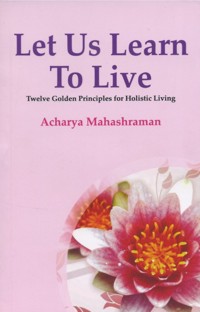Jain scriptures proffer multifaceted wisdom complete with pragmatic solutions to better our lives. Long ago, a newly initiated disciple asked his Guru, "Now that I have become a monk, how should I shield myself from the bondage of new Karmas? What is expected of me in my new role? What makes me different from a lay person? In what manner should I consume by food? Which physical activities should I limit, or refrain from engaging in - sitting, walking, talking or sleeping?" The Guru replied, "All these activities are essential in the normal course of life. You must continue with these as you have always done. The only difference, my son, is now you should do them with Awareness."
Jainism's most noteworthy contribution to the world is a comprehensive thesis on the Ahimsic way of life. It is the foundation of Right Conduct that extends beyond mere physical action and applies to every conscious and unconscious thought in our mind. Society invariably employs punishment to contain physical violence. How do we restrain a wandering mind steeped in negative fantasies, emotions, and intentions? The path of Ahimsa begins with heightening of an individual's level of awareness, as this is the precursor to mental training for the state of Equanimity or Samata. Equanimity and Ahimsa are two sides of the same coin. Ahimsa is the philosophy and Equanimity is the goal. In this book, Acharya Mahashraman, whose disciples revere him for his unparalleled equanimous disposition, describes a systematic approach towards increasing our level of awareness.
"Dasavaikalika", one of the Jain scriptures, provides a detailed description of conduct for "artistic living." Acharya Mahashraman has extensively quoted from this great resource of wisdom. His interpretation of "Dasavaikalika", coupled with his own prudent and astute observations in his sermons and writings, has formed the basis °f the "twelve golden principles" in this book, which are aimed at refining not only the inner-self but also the overall personality.
A few years ago, while contemplating a prior discussion session with some of the younger participants of the JVB Center in Houston, the thought of translating this book - authored by Acharya Mahashraman - into English came to mind. The idea was to advance his simple and very practical message beyond those who occasionally study the Jain philosophy to reach a much larger readership. As far as the potential obstacles of language were concerned, I consider myself an ongoing student of the English language, keen on expanding my vocabulary and proficiency. I fully realized that this project would be a daunting task, but I felt energized and inspired by the blessings of my great Gurus. A strong positive inner force solidified my resolve to try. Despite starting off as a novice in the area of accurately translating a book, I convinced myself that there was nothing to lose in this endeavor and the opportunity to share this valuable work with others became my guiding motivation. In this project I received help from Rajeemati Sethia of Mumbai who assisted in typing this work and Mrs. Lalita Dhariwal of Raipur, who was equally helpful in editing the text.
Early on in this process, I realized that - as is often encountered in any translation - my work lacked a natural flow and I had to make it more appealing so the reader would not lose interest after just a few pages. The well known phrase, "lost in translation" became a frustrating reality that I had to accept and painstakingly work through. However I remained determined to maintain the integrity and sanctity of the message and to not distort the expression or the intent of what had been conveyed in Hindi by Acharya Mahashraman.
In 2004, when I once again returned to the U.S., I discussed my concerns and thoughts with Mr. Chetan Sanghvi, Dr. Sukh Sampat Mehta and his daughter Sangeeta Mehta. We all went through the translation process several more times. Finally, we were confident that we had achieved the goal of refining the words, sentences and paragraphs as well as adding some flavor to the language. This conviction was echoed by Mr. Gordon Anderson, a devotee of JVB Center, Houston, after a thorough read of the resulting manuscript. The progress was slow - this effort took nearly two years to complete. In accomplishing this prolonged effort I must not forget Muni Kumar Shraman ji for many reasons. Since this work was done with the inspiration of spreading the works of Jainism through Acharya, I was very happy with the final results.
The manuscript was sent for review and comments to Prof. Glenn D. Paige (Center for Global Nonviolence, Honolulu and author of "Non-killing Global Political Science"), Prof. Anne Vallely, PhD (Department of Religion, University of Ottawa, Canada) and Prof. Gary L. Francione (Distinguished Professor of Law and Philosophy, Rutgers University School of Law). I deeply appreciate their gracious and thoughtful endorsements. My gratitude also goes to Professor Padmanabh Jaini for his scholarly and painstaking review of the scriptures from which this book has drawn the pedestal references. Although he generally doesn't write book reviews he provided an in-depth analysis of the Sanskrit poetry quoted in the book in order to encourage me in my first effort. Moreover, I treasure the very inspiring note Professor Jaini sent to Mr. Chetan Sanghvi. It reads as follows..."I have received the draft of the translation of the booklet by Shri Yuvacharya Mahashraman. I have not seen the original Hindi work. Even so, I must say that this is an excellent translation. It retains the original flavor of the sermon like the writing of the Yuvacharya, and provides an ideal guidebook for students of Jainism......... "
I am deeply grateful to Mr. Ranjit Dugar, head of the charitable trust "Spiritual Quest, Kolkata" for volunteering to take on the sole responsibility of publishing this book. What was once just a thought has now come to tangible and meaningful fruition.
So come, let us all reflect upon living a holistic life. It begins with introspection, self-evaluation and practicing a conscious "mindfulness" in every voluntary activity. Practitioners can experience true grace in their life and can expect to be rewarded with an enlightened understanding of our essential daily activities. Finally, I would like to once again convey my wholehearted thanks to each and every contributor who participated in this endeavor. This unique, collaborative experience reminds me of how blessed I am to have a Guru who leads me step by step to my final destination and equally how fortunate I am to have such esteemed people as resources to assist in taking this project to its completion.
Samani Sanmati Pragya
 Acharya Mahashraman
Acharya Mahashraman

